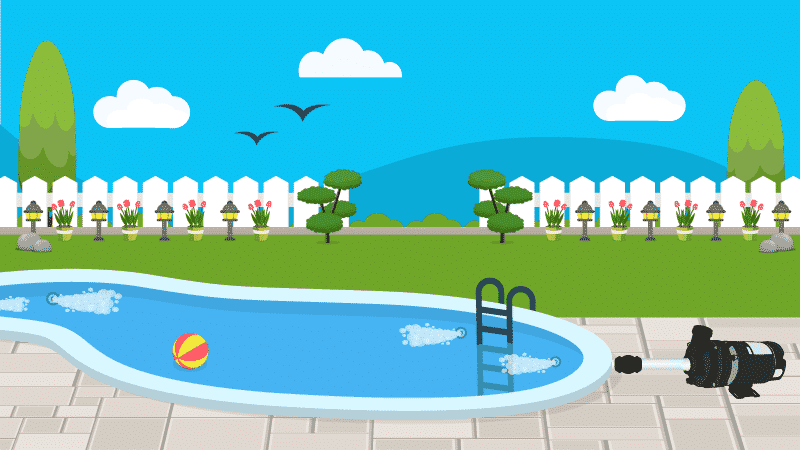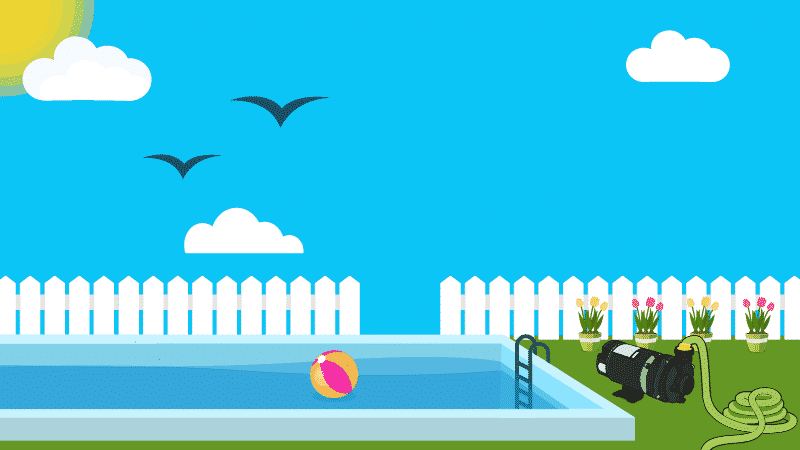How Does a Pool Pump Work to Keep Your Pool Perfect?
Your pump is one of the most important pieces of equipment in your pool. Without it, your water wouldn’t circulate through your filter system, and your pool would be disgusting and stagnant.
But how does a pump actually work? And what do you do when your pump’s NOT working? Here’s everything you need to know about pool pumps and how to troubleshoot them. Let’s dive in.
Stop wasting time and money with confusing water chemistry and maintenance. Our effortless system guarantees to keep your pool balanced, sanitized, and crystal clear all year. Works for all pools including saltwater.
How Does a Pool Pump Work?
Your pump is the heart of your pool, pumping water through your plumbing and filter system. So when your pump is running, your water is actively getting filtered, and it helps circulate and disperse any chemicals in your water.
Here’s how the water flows:
- Your pump sucks in water from the pool through the skimmers or main drains and into the suction lines. This is called the Suction Side of your pool.
- As the water passes through your pump, the force changes from pulling to pushing, and the pump pushes the water into the filter. You might also have a heater, chlorinator, or salt system after the filter.
- After it passes through the filter, the water is pushed through the return lines through the pressure side. It then flows out your return jets back into your pool.
If you look at the plumbing lines that lead to your pump, you might see one or more valves. These control the water flowing into the pump. You might use these valves to temporarily stop the flow of water if you need to work on your pump or filter system. It might be a simple shut-off valve or a three-way valve that controls the flow of water from the skimmers or the main drain.
The Anatomy of a Pool Pump
Knowing each piece is really helpful for troubleshooting pump problems.
- The Pump Lid: The lid needs to be completely sealed tight to keep air out of your pump and the suction in your lines.
- The Pump Strainer Housing with the Pump Basket: This is where pool water first enters the pump. The basket collects debris so it doesn’t clog up the pump’s spinning impeller.
- The Drain Plug. This is used to drain the pump during winterization. You may have more than one drain plug on your pump.
- The Pump Housing with the Impeller: This is the main control center where the impeller, diffuser, and seals live. The impeller spins on the motor shaft, creating a vacuum that pulls water from your pool and pushes it toward your filter. If it gets clogged or jammed, the whole pump can stop working.
- The Pump Motor and Shaft: This is where the motor lives, and that’s what spins the impeller.

What’s The Right Pump Size For Your Pool?
Your pump needs to be powerful enough to pull in and filter ALL the water in your pool at least once a day. This is called the turnover rate. It usually means running your pump for at least 8 hours a day to filter all of your water. But if you want an exact number, here’s how to calculate your turnover rate:
- Start with your pool’s volume in gallons
- Divide that by your pump’s horsepower or flow rate, which is usually in Gallons per Minute
- That will give you your turnover rate in minutes.
For example, if your pool is 15,000 gallons and you have a pump with a flow rate of 40 GPM (or gallons per minute), you’ll have a turnover rate of 375 minutes. That means it takes a little over 6 hours to filter all the water in your pool. Making sure your pump is running enough can help prevent some water issues.
Pump Maintenance and Troubleshooting Tips
Here’s what to check on to make sure your pool pump is working properly. This is especially important if your pump has been turned off for a while.
1. Check Your Pump Basket
Any debris not caught in your skimmer basket can make its way to your pump basket. Check and empty your pump basket, and only remove it when the pump is off.
2. Check Your Pump Lid Seal
If your pump lid isn’t sealed properly, air can get into your system. Check the lid’s O-ring for cracks and damage. Use a lubricant specifically made for O-rings or replace the O-ring if it’s completely worn out.
3. Check Your Pump Connections
Any weak connections can introduce air into the system. So, inspect the unions and connection points between the pump and plumbing lines. You may want to consider adding plumber’s tape to loser connection points to prevent air leaks.
4. Keep Your Water Level At Least Halfway Up the Skimmer
If it dips too low, your pump can start sucking in air. And worse, your pump can start to run dry and overheat.
5. Clean Your Skimmer Basket and Filter Regularly
If water isn’t flowing through the skimmer or the filter properly, your pump will struggle. So empty your skimmer basket once a week and backwash or clean your filter when the pressure starts to creep up.
6. Check Your Skimmer Line
Sometimes, a pair of goggles or a hair scrunchie can get caught in the skimmer line, blocking the flow of water to your pump. If you think your skimmer line is clogged, check out our other video on unclogging your skimmer.
Your Pool Pump Still Isn’t Working? Here Are More Things to Try…
- If the water flow is low in your pump but the pump itself is running, you probably need to prime your pump. This can happen when air gets sucked in through the skimmer after you’ve shut off the pump. Prime the pump by filling it with a garden hose for 2 to 3 minutes while the pump is turned off. Then quickly reseal the pump lid and turn your system back on. You can also use the air relief valve on your filter to help remove air from the lines as your pump is starting. If you need more pump priming help, check out our other guide. Just make sure you’ve gone through the check list from earlier first.
- If you think there’s an air leak but you’re not sure where it’s coming from, use the shaving cream trik. Spread a little shaving cream on possible problem areas. If there’s an air leak, say at one of the unions or on the pump lid, the air will suck in the shaving cream, leaving an indent.
- Finally, if your pump isn’t running and its making a humming sound, it means there’s something wrong with the motor. Try resetting your breaker and check your pump’s impeller to see if it’s jammed. Check out our other video all about fixing your pump if it’s making weird noises.
4 Ways We Can Help With Your Pool
- Pool Care Cheat Sheets (Free): Easy-to-use downloadable guides to help you keep track of taking care of your pool this year.
- The Pool Care Handbook: An illustrated guide to DIY pool care, including water chemistry, maintenance, troubleshooting, and more.
- The Pool Care Video Course: You’ll get 30+ step-by-step videos and a downloadable guide with everything you need to know about pool maintenance.
- The Pool Care App: Enter your water test results. Get a custom treatment plan. Know exactly what chemicals to add to keep your pool clear.









